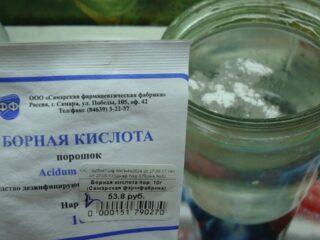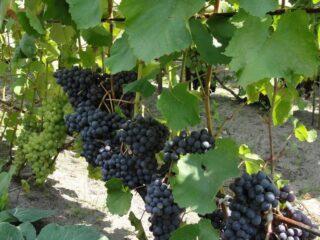Content
Growing grapes is steadily gaining popularity among Russian gardeners. However, not everyone manages to “make friends” with culture. Caring for vines takes a lot of time and effort; its integral component is the prevention of infection by pathogenic microflora. One of the most dangerous diseases is gray rot of grapes. It is quite possible to cope with it if you are able to recognize it in time.
Why is gray mold dangerous?
Gray mold is a disease that develops quite slowly. The fungus gradually affects different parts of the vines and leads to their death. The growth of grapes is greatly inhibited, since the pathogen negatively affects all processes necessary for its normal development, primarily photosynthesis and metabolism. The shoots grow very slowly, fruit clusters and flower buds for the next season are not formed at all or are deformed.
As a result, parts of the vine affected by gray rot die en masse. General tone and immunity drop sharply. The plant gradually withers and dies.
In terms of the degree of danger for grapes, gray rot is placed on a par with mildew and oidium. The worst option is considered to be damage to the berries by the pathogen.

Gray rot spreads very quickly from one grape to another, entire bunches disappear
Causes
There are many ways in which botrytis fungus spores can get onto grapes. They are easily transported over long distances by wind, insects, birds, and animals. Sometimes the gardener himself becomes the “peddler”, neglecting to disinfect equipment, tools, and work gloves.
The vine can “pick up” the disease from plants already affected by the pathogen, located in the area not far from it. Gray mold is distinguished by its rare “omnivorous” nature; the vast majority of garden crops, both fruit-bearing and ornamental, can suffer from it. There is always a risk of purchasing already infected seedlings.
There are certain risk factors that increase the likelihood of contracting gray mold:
- mechanical damage to the bark of the vines and the skin of the berries;
- nutrient deficiency, incorrect and/or untimely feeding;
- intense heat and prolonged;
- excessive “crowding”;
- neglect of regular sanitary and formative pruning;
- contact of leaves and bunches with the soil surface;
- “storage” of plant debris in the garden plot.
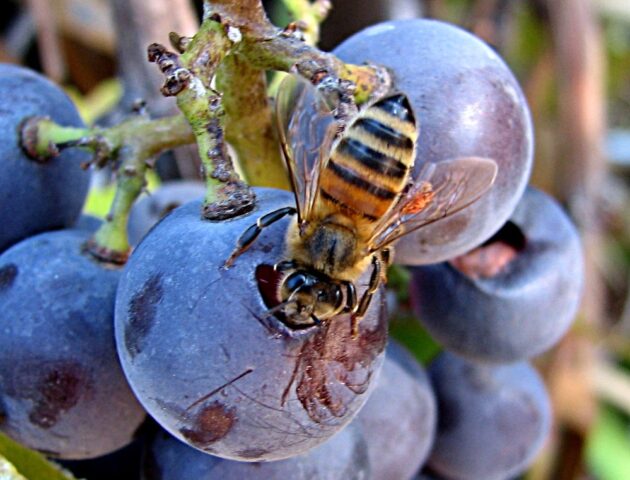
Any damage to the skin is a “gateway” for gray rot
Sometimes winegrowers deliberately infect grapes with gray (so-called “noble”) rot shortly before harvest. This includes the production technology of elite white dessert wines. Fruits affected by the fungus quickly dry out and “raisinize,” which provides the juice with the required thick consistency and sweetness.
On grapes used for the production of red wines, gray rot in any form is unacceptable. The fungus destroys anthocyanins, which provide the wort with its characteristic color.
What does gray rot look like on grapes?
The main symptom of gray rot on grapes is a “fluffy” silver-gray coating on any above-ground part of the plant. Small black “grains” are noticeable in it.
“Concomitant” symptoms of gray mold depend on what exactly is affected by the fungus:
- Grayish-brown “wetting” spots appear on the leaves. They dry out and fall off quite quickly.
- On the vines, certain areas of the bark become discolored. Gradually they expand, it is easily removed in whole layers. The lack of normal coloring with gray rot turns into tissue necrosis, the shoots dry out and die.
- The flowers turn pale, then turn brown. The flower stalks dry out and fall off en masse.
- The development of fruit clusters is greatly inhibited and they become deformed. The berries become covered with small “watery” spots, the skin darkens, and they become slimy to the touch. The grapes completely rot or become “mummified” and fall off.
- On the ridges, areas of tissue affected by gray rot change color to brown-green. These spots “dissolve”, they decay and die, which leads to the cessation of ripening of the berries in the cluster and their falling off.
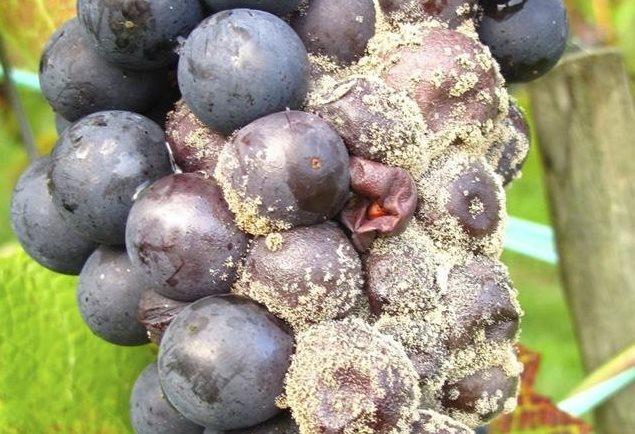
Gray rot can appear not only during the ripening of berries, but also after harvesting - during its transportation and storage
How to treat grapes for gray rot
The range of products for treating grapes against gray rot is quite wide. This includes “heavy artillery” in the form of “aggressive” chemicals and safer preparations of biological origin. In the early stages of infection, even folk remedies sometimes help to cope with the problem.
Folk remedies
The main advantage of folk remedies is their safety for human health, flora and fauna. Accordingly, such measures to combat gray rot of grapes can be practiced at any time, even shortly before harvest.
Grapes infected with gray rot can be treated:
- Onion or garlic infusion. Approximately 200 g of finely chopped “arrows”, “feathers” or the heads themselves are poured into 1 liter of hot water, left for 3-4 days, shaking occasionally. Then the liquid is filtered and diluted with water 1:2.
- Iodine solution. For 10 liters of water you need ten drops.
- Kefir, whey, yogurt. The product is diluted with water 1:5, iodine can be added if desired.
- Infusion of dry mustard. Powder (50 g) is poured into 5 liters of water and left for two days. Before use, strain and add another 5 liters of water.
- A solution of baking soda or soda ash. Working solution – 70-80 g per 10 liters of water.
- Pale pink solution of potassium permanganate (2-3 g per 10 liters of water).
- Foam of laundry or green potassium soap. Beat 40-50 g of small chips in 10 liters of water.

Soda solution not only destroys gray rot, but also increases the sweetness of berries
Preparations for gray rot on grapes
“Classic” drugs against gray rot on grapes are copper sulfate, Bordeaux mixture and potassium iodide. They are relatively safe for plants and the environment, but it is still recommended to stop treating vines 3-4 weeks before harvest.
A 3% solution of these drugs is used against gray rot. During processing, it is necessary to use personal protective equipment for the eyes and respiratory system, gloves, thick clothing and shoes to prevent liquid from coming into contact with the skin.
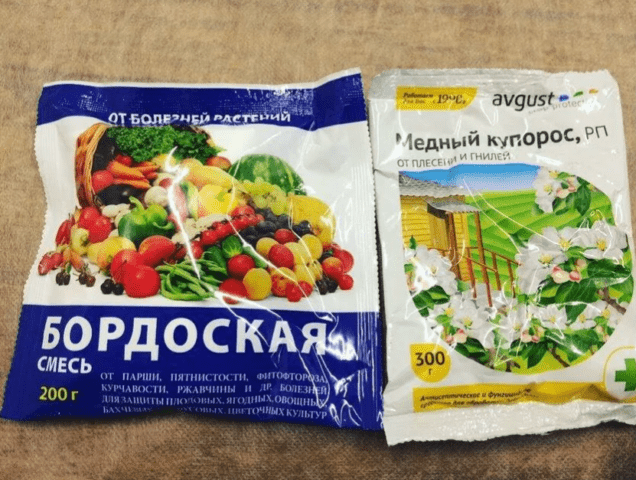
The working solution against gray rot is prepared strictly following the manufacturer's instructions
Fungicides for gray rot on grapes
Fungicides are destructive not only for gray rot, but also for any pathogenic fungi. They are divided into chemical and biological. The former are more effective and begin to act faster. But their use is impossible if there is less than a month left before the grape harvest. Some copper-containing preparations against gray rot cannot be used at the budding and flowering stage.
Ridomil-Gold
Provides grapes with protection from all types of rot, mildew and Phomopsis.Used for prevention or in the early stages of disease development. The fungus cannot develop resistance to it. If the instructions for use are not followed, it poses a danger to humans, flora and fauna, and accumulates in the soil.
A significant drawback of Ridomil-Gold is that after each rain it requires repeated treatment for gray rot.
Topaz
It is used mainly against oidium, but is also effective when infecting grapes with gray rot. It begins to act almost immediately - being absorbed into the tissue, it suppresses the activity of the fungus and destroys the mycelium. Does not affect the development of the vine or the ripening of berries.

The drug Topaz combines well with most fungicides, enhancing and prolonging the effect of treatment with them
Quadris
Fungicide against all the most dangerous diseases for grapes - mildew, oidium, gray rot. The product literally “cuts off oxygen” to the pathogen. The mycelium of the fungus begins to die en masse within an hour after spraying. It takes about two days to completely get rid of gray rot on grapes. Does not combine with herbicides.

Quadris not only destroys gray rot, but also has a positive effect on the appearance and taste of grapes
Agrotechnical techniques
Often the gardener himself becomes the “culprit” for infecting grapes with gray rot. To avoid this, it is necessary to study in advance the important nuances of agricultural technology:
- The right choice of place for grapes. Particularly important are good lighting, access to fresh air and the quality of the substrate.
- Providing plants with sufficient area for nutrition. With a deficiency of nutrients, their immunity decreases.
- Regular sanitary pruning in autumn and spring.To do this, use only sharply sharpened, disinfected tools, make the cuts even, and immediately cover them with garden varnish. All generated waste is burned. The same goes for weeds.
- Formation of a high trunk when growing grapes on a trellis. This eliminates contact of leaves and brushes with the soil and ensures good aeration of the plant.
- Weekly vineyard inspections. When symptoms resembling gray rot appear, all parts of the plant affected by it are cut off and destroyed.
- Refusal of excessive use of nitrogen-containing fertilizers. When there is an excess of them, the green mass begins to “fatten”, and the vine’s immunity drops.
- Immediate ventilation if gray rot appears on grapes growing in a greenhouse. If you do not reduce humidity, any measures to combat it will not be effective.
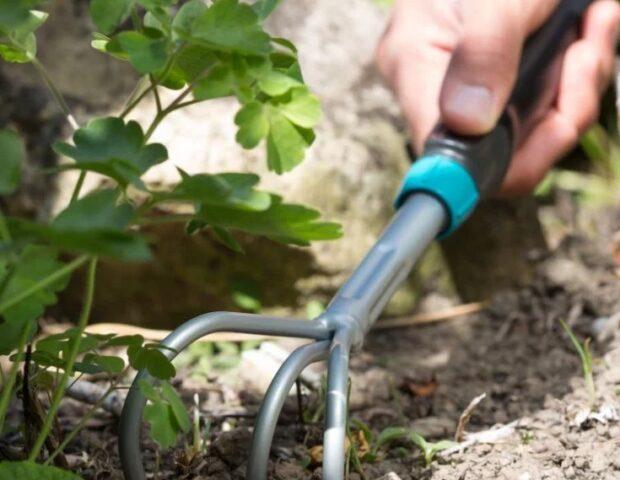
Loosening is necessary to destroy fungal spores in the soil
Prevention
Preventing grapes from becoming infected with gray rot is much easier than treating the vines later. Prevention is not particularly difficult:
- Carrying out two treatments with fungicides at the beginning and at the end of the active growing season.
- Purchasing seedlings from nurseries and other “official organizations” that guarantee their quality.
- Thorough removal of plant debris every autumn, deep loosening of the soil.
- Disinfection of garden tools and tools, substrate and containers used for grape propagation.
- Installing protective nets against birds and wasps to prevent mechanical damage to the berries.
- Removing leaves in contact with the soil, tying up low-lying bunches of grapes.
- Regulating the frequency and rate of irrigation, taking into account the intensity of natural precipitation.
- Timely application of fertilizers containing macro- and microelements necessary for grapes at this stage of development.
- Refusal to use cuttings from vines infected with gray mold as grafting material.
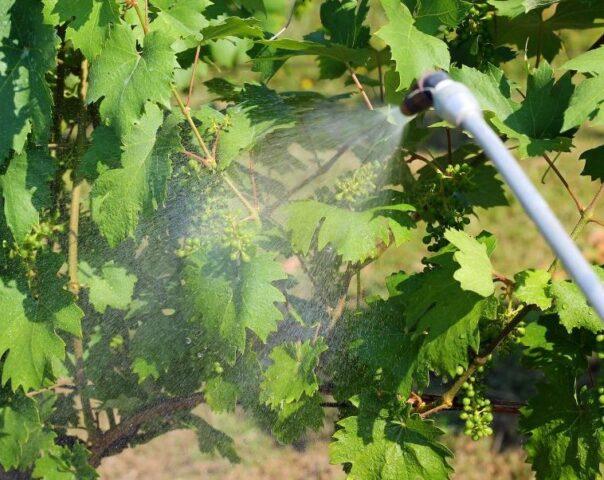
Even grape varieties resistant to gray rot need preventative fungicide treatments.
Grape varieties resistant to gray rot
There are no grapes that are 100% resistant to gray rot yet. Breeders have so far only managed to create varieties that are very resistant.
Flora
The vines of the Flora grape variety are medium-sized, the clusters are very large (about 1 kg, with quality care - up to 2.5 kg). The berries are elongated, greenish-white, with a pinkish tan, weighing 8-10 g. The pulp is very juicy and sweet, almost “crispy”. A universal variety, resistant to mildew, powdery mildew and gray rot.

Despite their large size, Flora grape berries contain only 2-3 small seeds
Bogatyanovsky
An early ripening table grape variety. The vine is vigorous, the leaves have pronounced bristles. The clusters are of a classic shape, weighing about 400 g. The berries are greenish-yellow, elongated, weighing 4-5 g. The pulp is very juicy, with a pronounced “cartilaginousness”. The grapes are valued for their good keeping quality, transportability, and high resistance to mildew and gray rot.

The sweet taste of Bogatyanovsky grapes is rated nine points out of ten by professional tasters
Agat Donskoy
Vigorous grapes with quickly ripening shoots. The leaf blades are slightly wrinkled. The mass of the bunches varies from 500 g to 1 kg, the shape of the berries is from round to oval. They weigh on average 5 g. The skin is thin but durable, blue-violet, with a pronounced waxy coating. The berries can be eaten fresh, processed into raisins or wine, or frozen. The variety is valued for its frost resistance down to -26 °C, its ability to adapt to the local climate and weather, and its high resistance to mildew and gray rot.

A relative disadvantage of the Agat Donskoy grape is its demanding conditions for cultivation and soil fertility
Pleven
Early ripening grapes mainly for the southern Russian regions. Resistant to fungal diseases, including gray rot, and pests. Wasps are not too interested in them. The bushes are tall and have a fast growth rate. The clusters are cone-shaped, weighing 300-350 g. The berries are greenish-yellow, with a pinkish “blush”. The skin is thin, the flesh is tender and juicy. The taste is distinctly sweet, with nutmeg notes. Grapes can be eaten fresh, dried, or used for home canning.

Due to the presence of bisexual flowers, Pleven grapes do not require “outside help” for pollination.
Pineapple
A variety used primarily in winemaking. The name is due to the characteristic pineapple aroma and taste of the pulp. It is highly resistant to mildew and gray rot. Vines of medium height and vigor. The clusters are small (up to 300 g), cylindrical. The skin is thin, rich yellow-green, the flesh is tender and sweet. In central Russia, this grape does not need shelter, it is unpretentious in care, valued for its keeping quality and transportability, and consistently high yield.

Pineapple grapes are rarely attacked by wasps and aphids
Purple early
An early ripening variety that does not require shelter for the winter in temperate climates. The harvest ripens in early August. The vines are tall and vigorous. The flowers are bisexual. The brushes are small (about 200 g), cone-shaped. The berries are round-oval, weighing 4-5 g. The skin is elastic, deep purple in color, with a pronounced waxy coating. The grapes are very sweet, with a strong muscat aroma and aftertaste. The variety is characterized by high immunity to any pathogenic microflora.

Early Violet grapes are suitable for squeezing juice; they are used as “raw materials” for homemade wines and champagne
Conclusion
Gray rot of grapes, if nothing is done, may well destroy not only the crop of the current season, but also the vines themselves. However, there are simple preventive measures that significantly reduce the risk of developing this disease. When gray mold infection cannot be avoided, folk remedies can help in the early stages. In advanced cases, it is necessary to resort to the help of fungicides and other drugs.
